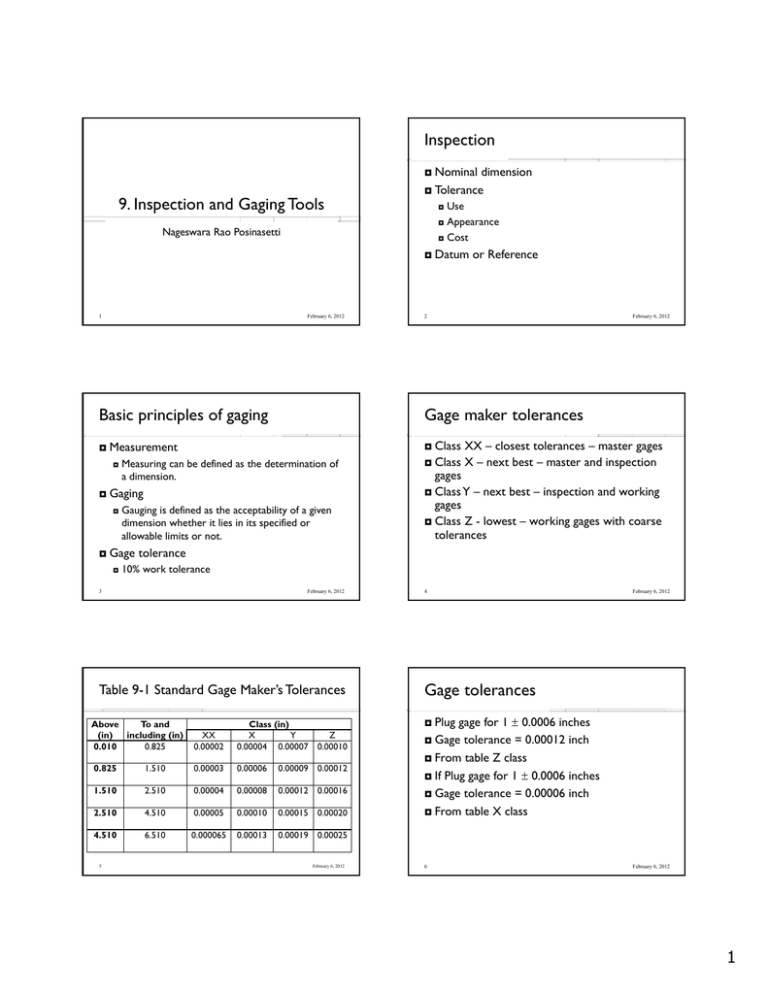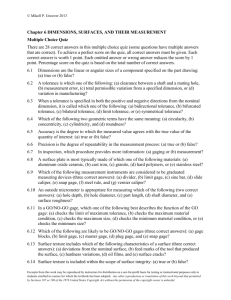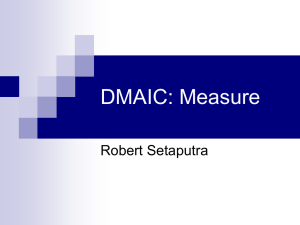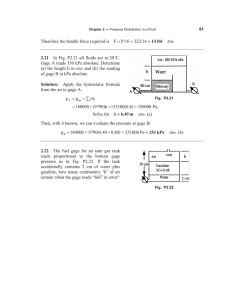9. Inspection and Gaging Tools Inspection Basic principles of gaging
advertisement

Inspection 9. Inspection and Gaging Tools Use Appearance Cost Nageswara Rao Posinasetti 1 February 6, 2012 Basic principles of gaging February 6, 2012 Class XX – closest tolerances – master gages Class X – next best – master and inspection gages Class Y – next best – inspection and working gages Class Z - lowest – working gages with coarse tolerances Measuring can be defined as the determination of a dimension. Gauging is defined as the acceptability of a given dimension whether it lies in its specified or allowable limits or not. Gage tolerance 10% work tolerance 3 February 6, 2012 Table 9-1 Standard Gage Maker’s Tolerances Above To and (in) including (in) 0.010 0.825 XX 0.00002 Class (in) X Y Z 0.00004 0.00007 0.00010 0.825 1.510 0.00003 0.00006 0.00009 0.00012 1.510 2.510 0.00004 0.00008 0.00012 0.00016 2.510 4.510 0.00005 0.00010 0.00015 0.00020 4.510 6.510 0.000065 0.00013 0.00019 0.00025 5 2 Gaging Datum or Reference Gage maker tolerances Measurement Nominal dimension Tolerance February 6, 2012 4 February 6, 2012 Gage tolerances Plug gage for 1 0.0006 inches Gage tolerance = 0.00012 inch From table Z class If Plug gage for 1 0.0006 inches Gage tolerance = 0.00006 inch From table X class 6 February 6, 2012 1 Gage tolerances Allocation of gage tolerances Plug gage for 1 0.0075 inches Gage tolerance = 0.0015 inch From table Z class Smaller degree of gage tolerance means more expensive Gage tolerances should be realistically applied. 7 February 6, 2012 Maximum Work Tolerance limit Bilateral system The GO and NOGO gage tolerance zones are divided into two parts by the high and low limits of the workpiece tolerance zone 8 February 6, 2012 Allocation of gage tolerances Hole to be gaged 1.2500 0.0006 inch Work tolerance = 0.0012 inch Hole size from 1.2506 to 1.2494 inch Gage tolerance (10%) = 0.00012 inch Z-class tolerance zone GO gage size 1.2494 0.00006 inch NOGO gage size 1.2506 0.00006 inch 9 Bilateral Work tolerance zone Minimum Work Tolerance limit February 6, 2012 Table 9-1 Standard Gage Maker’s Tolerances Above To and (in) including (in) 0.010 0.825 XX 0.00002 Class (in) X Y Z 0.00004 0.00007 0.00010 0.825 1.510 0.00003 0.00006 0.00009 0.00012 1.510 2.510 0.00004 0.00008 0.00012 0.00016 2.510 4.510 0.00005 0.00010 0.00015 0.00020 4.510 6.510 0.000065 0.00013 0.00019 0.00025 11 February 6, 2012 10 February 6, 2012 Allocation of Gage Tolerances Unilateral system The work tolerance zone entirely includes the gage tolerance zone Work tolerance smaller by the sum of the gage tolerance 12 February 6, 2012 2 Maximum Work Tolerance limit Allocation of gage tolerances Hole to be gaged 1.2500 0.0006 inch Work tolerance = 0.0012 inch Hole size from 1.2506 to 1.2494 inch Gage tolerance (10%) = 0.00012 inch Z-class tolerance zone GO gage size 1.24940 + 0.00012 inch NOGO gage size 1.25060 - 0.00012 inch Unilateral February 6, 2012 14 Maximum Work Tolerance limit Allocation of gage tolerances Commercial gages Work tolerance zone Allocate gage tolerance negatively with reference to both the maximum and minimum limits of the workpiece tolerance (C) NOGO gage tolerance is divided by the maximum limit of the workpiece tolerance and the GO gage tolerance is held within the minimum limit of the workpiece tolerance. 15 February 6, 2012 Allocation of gage tolerances 17 February 6, 2012 16 Minimum Work Tolerance limit Commercial Plain plug Minimum Work Tolerance limit Commercial Plain ring 13 Bilateral Work tolerance zone February 6, 2012 Gage Wear Allowance The objectives in choosing an allowance system should be the economic production of as near 100% usable parts as possible, and the acceptance of the good pieces and rejection of the bad. February 6, 2012 Wear allowance is an amount added to the nominal diameter of a GO-plug and subtracted from that of a GO-ring gage. It is used up during the gage life by wearing away of the gage metal. 18 February 6, 2012 3 Gage Wear Allowance (5%) Hole diameter 1.5000 0.0006 inch Work tolerance = 0.0012 inch Gage tolerance (10%) = 0.00012 inch GO gage size 1.49940 + 0.00006 = 1.49946 inch Add gage maker tolerance as shown previously, 1.49946 +0.00012 and –0.00000 as limits 20 February 6, 2012 Gage Materials Surface Plate Chrome plated Tungsten carbide tipped Main horizontal reference plane Rigid block of granite or cast iron Generally have three-point suspension to prevent rocking when mounted on uneven surface Two types 21 February 6, 2012 Cast-iron plates Granite surface plates 22 Surface Plate Advantages of Granite Plates Cast-iron plates Well ribbed and high strength Good wear-resistance qualities After machined, surface scraped by hand to flat Operation long and cost high Granite surface plates Manufactured from gray, pink, or black granite Several degrees of accuracy Extremely flat finishes produced by lapping 23 February 6, 2012 February 6, 2012 Not appreciably affected by temperature change Will not burr, therefore, accuracy not impaired Nonmagnetic Rustproof Abrasives will not embed themselves as easily in the surface 24 February 6, 2012 4 Template Specified profile Guide to the location of workpiece features with reference to a single plane. A straight edge is a template for checking straightness. Radius gages Screw pitch gages 25 February 6, 2012 26 February 6, 2012 28 February 6, 2012 Fig 9-6 Gaging the profile of a workpiece with a template 27 February 6, 2012 Plug Gages A plug gage is a fixed gage usually made up of two members One member is called the GO end and the other the NO-GO or NOT-GO end AGD – American Gage Design standards 29 February 6, 2012 30 February 6, 2012 5 31 February 6, 2012 32 February 6, 2012 Ring gages Ring gages are usually used in pairs, consisting of go member and no-go member. 33 February 6, 2012 34 February 6, 2012 35 February 6, 2012 36 February 6, 2012 6 Snap Gages For measuring length, diameter, thickness or width 37 February 6, 2012 38 February 6, 2012 39 February 6, 2012 40 February 6, 2012 41 February 6, 2012 42 February 6, 2012 7 Amplification and Magnification of Error As the measurable error becomes small, it is difficult for direct reading and hence some means of magnification is required. Dial indicators Optical Pneumatic gauging 43 February 6, 2012 44 February 6, 2012 45 February 6, 2012 46 February 6, 2012 47 February 6, 2012 48 February 6, 2012 8 49 February 6, 2012 50 February 6, 2012 February 6, 2012 52 February 6, 2012 54 February 6, 2012 Geometric Dimensioning and Tolerancing ASME Y14.5-1994 (Rev. 2009) ISO 1101, 129, 3040 51 Modifiers Maximum Material Condition (MMC) Least Material Condition (LMC) 53 Minimum diameter of a hole and maximum diameter of a shaft Maximum diameter of a hole and minimum diameter of a shaft February 6, 2012 9 Flatness checking Checking process depends upon the accuracy required Using a dial indicator After the surface is leveled, the indicator explores the entire area and the full indicator movement is a measure of flatness. 55 February 6, 2012 56 February 6, 2012 58 February 6, 2012 Checking a Profile Follow a master part as shown in Fig 9-42. Number of dial indicators set in a plane confirming the contour as shown in Fig 9-43. 57 February 6, 2012 Checking for Parallelism/Perpendicularity Parallelism can be checked by placing a part on a surface plate and searching for out of parallel condition with an indicator. Some times a special fixture may be required as shown in Fig 9-49. Perpendicularity of a cylindrical feature and it MMC can be checked with a functional gage as shown in Fig 9-51. 59 February 6, 2012 60 February 6, 2012 10 61 February 6, 2012 62 February 6, 2012 Fig 9-52 Gage for checking parallelism – cylindrical size feature Fig 9-52 Gage for checking parallelism – cylindrical size feature 63 64 February 6, 2012 66 February 6, 2012 February 6, 2012 Checking a Runout Total runout consists, by definition, of two concentric cylinders that encompass a feature about a defined axis. Generally, total runout is measured by taking single runout at intervals along an entire cylinder. The extremes of needle deflection for the entire set of intervals yields total runout. 65 February 6, 2012 11 67 February 6, 2012 68 February 6, 2012 Checking a Position Two holes that need to be gaged. Shown is a hole relation gage to check holeto-hole relationship. If RFS (Regardless of Feature Size) is used in place of MMC, gaging will become difficult. To maintain the positional tolerance of 0.10 in eleven gage pins will be required for all sizes between MMC and LMC. 69 February 6, 2012 70 February 6, 2012 71 February 6, 2012 72 February 6, 2012 12 73 February 6, 2012 74 February 6, 2012 Positional Tolerance Rules For parts with internal features, the nominal gage feature size is directly determined by subtracting the total positional tolerance specified at MMC from the specified MMC size of the feature to be gaged for location. For parts with external features, the nominal gage feature size is directly determined by adding the total positional tolerance specified at MMC size of the feature to be gaged for location. 75 February 6, 2012 76 February 6, 2012 77 February 6, 2012 78 February 6, 2012 13 79 February 6, 2012 80 February 6, 2012 81 February 6, 2012 82 February 6, 2012 83 February 6, 2012 84 February 6, 2012 14 85 February 6, 2012 86 February 6, 2012 87 February 6, 2012 88 February 6, 2012 89 February 6, 2012 15


